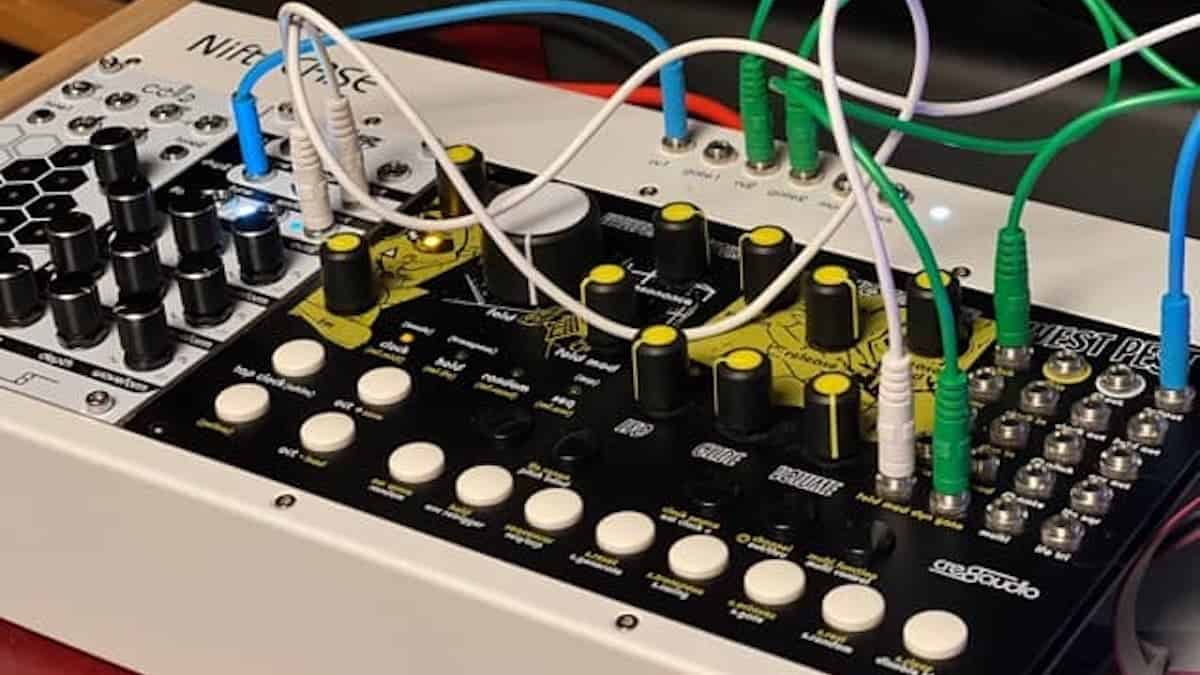Analog
Modular Memoirs Part 4: A CV Is Not A Resumé

The chronicles of a new Eurorack setup
In Part 3 of this series I installed my modules into the NiftyCASE and hooked them up to the power strip. Now it’s finally time to fire them up and get to the fun stuff.

Among the many benefits of the Cre8Audio NiftyCASE are its built-in USB and MIDI jacks, which allow direct connection to a DAW (in my case Apple Logic Pro).
After plugging the NiftyCASE’s USB port into one of my Mac’s USB 2.0 ports, I launched Logic and inserted an External Instrument on an Instrument track. This is a feature in Logic that lets you treat hardware instruments as if they’re instrument plug-ins. You just select the NiftyCASE as the track’s MIDI port and the audio interface input it’s connected to.

MIDI and voltage. There are some special modes for how MIDI operates in the NiftyCASE. Data sent to MIDI Channel 1 controls CV 1 and Gate 1, while MIDI Channel 2 controls CV 2 and Gate 2. In addition, sending MIDI on Channel 3 results in duophonic (2-note) polyphony: the first note played goes to CV1 and Gate 1, the second goes to CV2 and Gate 2.
When sending out on MIDI Channel 10, the first five top jacks behave as gates, useful for triggering drum or other percussive pitch-less modules. The NiftyCASE’s LED lights blink when receiving MIDI data, which is helpful visual confirmation that the USB connection is working.
While MIDI can contain all sorts of useful data, its most important function is transmitting played notes’ pitches and start/stop signals (Note-ons and -offs). In modular setups, all the MIDI information has to be converted into analog voltage.
Control Voltage (CV) manages the pitch data and the Gate voltage switches the note on or off. Each 1 volt represents an octave, for a total range of ten octaves (from 0 to 10 volts). So a CV signal of 2 volts is an octave higher than a 1 volt signal, and so on. Similarly, notes in the scale are represented by fractions of a volt, so the various oscillators play the right pitches.
This might seem a tad overwhelming at first, but the key concept is that playing a note typically requires two patch cables: one for the CV/pitch information, one for the Gate start/stop. Of course, CV and Gate voltages can also be used for all sorts of other fun stuff – controlling filters, LFOs, volume, and a bunch of other more esoteric effects.
The NiftyCASE also provides a Sync pulse voltage for controlling the tempo of hardware sequencers and other tempo-based modules.
Music. One striking difference that I discovered between modular synths and software instrument plug-ins is that tuning can be a major issue. I was quite surprised to see major deviations in the range of 20-30 cents sharp or flat between different octaves. Thankfully most modular oscillators have tuning options, and I recommend inserting a guitar tuner plug-in in the appropriate channel strip.
To play my MIDI controller and hear the Cre8Audio West Pest synth’s output in Logic – and have notes start and stop when I trigger them – I patched CV 1 to the synth’s Pitch input and Gate 1 to its Dynamic Gate input.
I programmed a simple arpeggiated ostinato line on the West Pest, to which I added some delay and reverb in Logic for good measure. Cre8Audio’s Chipz module has two LFOs, one of which I had drive the synth’s Fold Modulation to add some interest to the sound.
Next I patched CV 2 into the Chipz’ oscillators to play a lead melody line. Unfortunately Chipz doesn’t have a Gate input, which means the sound is always on. Until I can get myself a dedicated VCA module, my workaround was to plug and unplug the Chipz output from the NiftyCASE – rudimentary, but it worked!
Patching modules into other modules can be quite addictive, and it’s at the heart of modular synthesis. While I wanted to continue to patch more CV signals between the modules to make things even more interesting… I ran out of patch cables.
Lastly, I pulled up a simple drum loop in Logic to add a rhythmic groove to the modular synth lines.
Transformation. I ended up bouncing my track to disk in real time while doing a great deal of knob tweaking and plugging and unplugging the Chipz’ output. This is where I realized that modular synths can be living, breathing instruments full of nuance and subtlety. And they can require mastering a level of performance akin to playing an acoustic instrument.
But this can be a truly transformative experience, especially after so many years of just using plug-ins. To get a better idea of what playing a modular system is like, check out this incredible performance from modular synth artist Loula Yorke.
What my first timid, affordable steps into modularity have taught me is that I’m still far off from a true, fully modular set up. Being a semi-modular synth, the West Pest has limited patching options, and the lack of a dedicated VCA and VCF limits Chipz’ playability.
If I’m to push further into the Eurorack way of making music, I’ll need to acquire more modules. Clearly, this can quickly become a very expensive endeavor.
Next installment: a dive into Eurorack sequencing, as I finally hook up and use the Eventide Misha. Stay tuned.



















